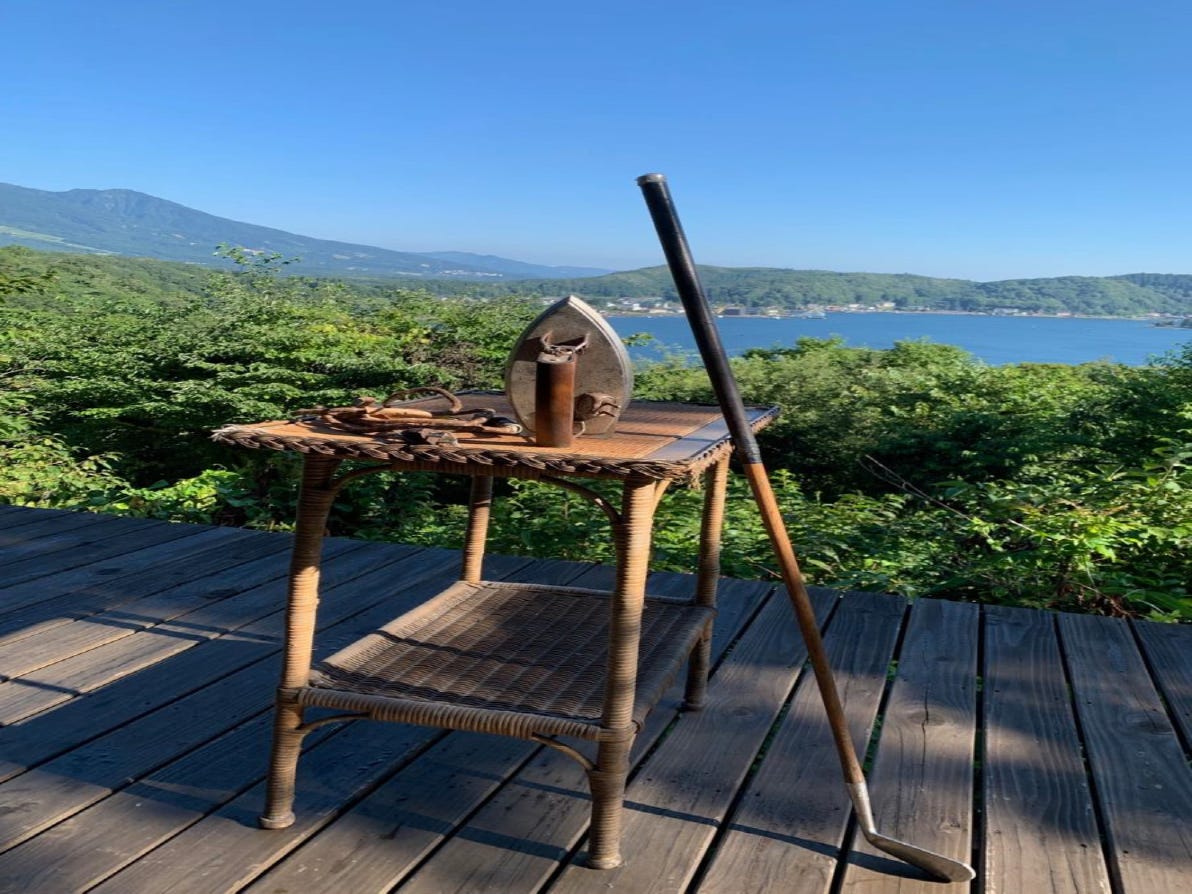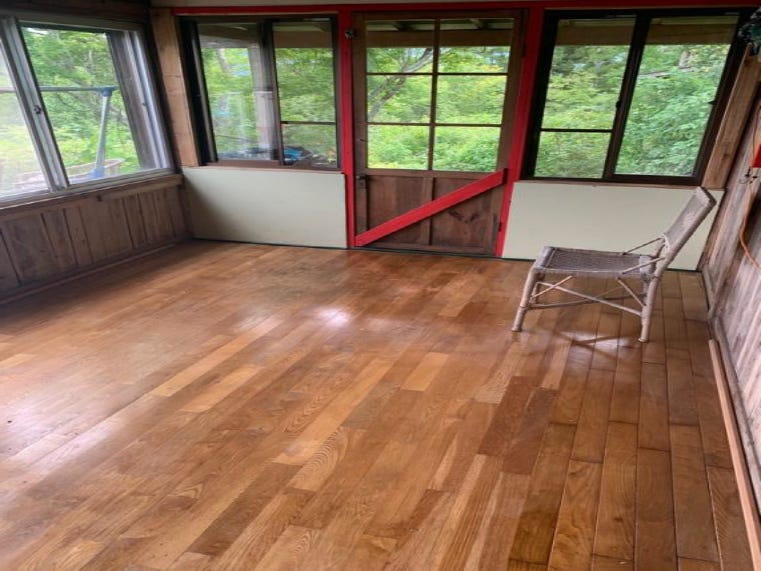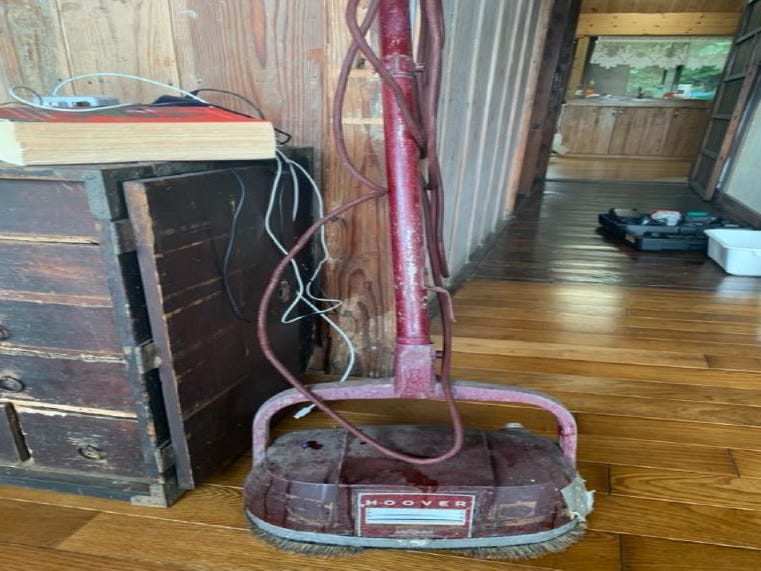We’ve accumulated generations of debris at our 1926 summer cabin that’s now within the boundaries of Japan’s new national park (Myôkô-Togakushi Renzan). It was the place that Joan’s family took outdated appliances since the early ‘60s; we still have a few objects from her mother’s wedding trousseau, like the single-setting travel iron from 1948. But unless an item has historical significance or an emotional attachment, we would be wont to toss it. That’s not so easy.
1948 travel iron, alongside one of our golf clubs with wooden shafts
We upgraded our washing machine a few years ago, once we got running water. The old one had to be advanced manually, and water drained or added, clothes moved from one tub to another, through wash/rinse/spin. We snagged a cheap Chinese model at a second-hand store that could cycle through automatically. But by saving a few bucks, we were left to deal with the old machine on our own. Violating community regulations and aesthetic sensibilities, we just leaned it up against our shaded, leafy slope. In our defense, our options were limited. The single local electronic retailer, Kobayashi Denki, would only recycle models that he sold you, and then only if there was space available in his storage room, which along with his showroom was the ground floor of his house. He would then charge what it cost for shipping the appliance back to its maker, plus something for his trouble. [The same rules apply to TVs, fridges, freezers and dryers.] Otherwise, you must haul it yourself fifteen miles down the mountain to Nagano’s Designated Electric Home Appliance Recycling Exchange that, I note, is not found on Google maps. But first you have to identify the recycling fee corresponding to its make and model from their Japanese-only web site and then pay that through a local post office prior to arrival. We were sort of hoping that our machine would sink into the slope at the back of the cabin, but we mostly rely on neighbors not to rat us out to the appliance police.
The cabin is also a repository of idle dreams and repressed trauma. Each summer Joan reads at least one of the moldering paperbacks that were favorites of her mother: Georgette Heyer’s Regency romances have been a go-to, but this year she started with the Karen series, heart-warming tales from the 50’s of an indomitable disabled child overcoming hardships through her family’s love and support — it’s a way for Joan to commune with her mom’s mindset. As a young teen our daughter Yumi spent an entire season in a funk, parked immediately in front of a standing fan set to high, surfing off a neighbor’s unlocked Wifi; she never left the cabin and hated every minute of it. Joan embraces the cabin’s considerable quirks as charm points. Yumi always saw it as a dump, quick to spot defects, even after we added a flush toilet and (cold) running water. But since Yumi lives in Japan, and now has a kid (2 years, 9 months) who might thrive in a multilingual, lake-side low key resort community, our principal aspiration this summer was to cultivate the idea that she would (eventually) take it over.
The cabin’s grip is rooted in Joan’s childhood. It was where she learned to socialize in English outside of her immediate family, and the only home her parents ever owned (parsonages came with the job and changed with each posting). But it was also a place where we would retreat with our kids to extend our sojourns in Japan and, I suppose, a space where I could interact and contribute since my childish Japanese is not suitable for my age or station. Over the years I put in a lot of sweat equity, though improvements were limited by my skill set. Eventually, in 2011 our Episcopal carpenter/priest from Kyoto came up with me in the off season, and with his power tools we got projects done: he put in a new kitchen, shored up the structural integrity to carry the heavy snows (in snow country accumulations are measured in meters) and wrapped the exterior in Tyvek; I put down new flooring and tore out a rotten roof beam — riddled with carpenter ants, it crumbled to dust when hit with a hammer — which then required rebuilding an exterior wall and reinstalling the old front door we had stored in the back. There’s been a lot of time and treasure spent not just for improvements but for preservation of memories and practices that sustained our toehold in Japan.
Rebuilt wall with original front door of cabin
1951 Hoover floor polisher, at 785 brush rpm
Yumi came up with Sofia for successive long weekends. It’s about a three hour drive from their home on the northern slope of Mt. Fuji, but a fussy kid in a car seat can make that seem like an eternity. We spent considerable time and effort cleaning — having missed the three previous pandemic summers — and childproofing the cabin. We even tore out a wall between the bedrooms to improve light and air circulation. But we could never match the spotless standards and clutter-free aesthetic — Marie Kondo meets Scandinavian minimalism — that characterizes their apartment’s interior.
Sofia turned out to be very game, into everything, and racked up a series of firsts: wading into a lake solo rather fearlessly, up to her chin, sculling with her arms underwater to maintain balance (an early swimming lesson we teach to five year-olds), shucking corn (country living!), twice soaking in an onsen (hot springs) and racing around its sprawling tatami-mat cafeteria. Sofia preferred the onsen’s cold tubs (50 degrees F), a departure from the more familiar hot bath. It’s a long walk down the hill to the lake, and she bounded down every step, though the return trips often required capitulating to plaintive pleas to be carried. There was always an array of scattered, abandoned toys in the sand of the swim area that she preferred to her own newly bought Miffy set. Her mom has a keen sense of what’s needed: a sheer sun-protecting hoodie, suitable lotions, water shoes, a cute, hooded towel/cape for drying and changing, and of course plenty of wipes and waterproof pull ups. When we took our girls down back in the day they were lucky if we remembered to bring a towel.
A portion of NLA hillside with 250 cabins as seen from Lake Nojiri. A couple dozen fishing skiffs usually on the lake.
Before she started her career in Japan, Yumi (now 34) had worked for two years as a credentialed Montessori toddler teacher, wiping butts. It was a job she loved, but it paid in adorable. She used all the skills she honed there and threw herself into mothering, though there really wasn’t much choice. She took a six-month (unpaid) maternity leave from city hall, and then when she returned to work her colleagues were gracious and accommodating of her new role — time off whenever required, reduced workload — even addressing her in terms of her new status and station: “mom.” But she was effectively parenting solo. Her older (52) Brazilian husband Wagner leaves for work by 6:00 a.m. — so the morning routine, clothing, feeding and delivery to daycare fell on her — and he typically returns only after Sofia has been picked up, fed and bathed. Bedtime routines relied on breastfeeding. He just didn’t see a role for himself in childcare, though to his credit he would obsessively clean, wipe down every surface in the apartment and refold all clothes every night before heading off to the gym. He still meal-preps, making all his dinners for the week on Sundays, exact measures of lean proteins, healthy fats and supplements whipped in blender, packed in freezer baggies and then plopped out into a bowl, as Yumi says, “like a dog.” This meant he ate and shopped separately. Habits of a bachelor bodybuilder held fast.
Almost a year ago Yumi jumped into the sea, the Chinese expression for joining the private sector. She picked a job that was sold to her as entirely remote, entirely flex with AWS (Amazon Web Services). It meant she could be home and available for coverage of those inevitable sick days for Sofia – given the frequency of what goes around at daycare. Wagner didn’t quite see Yumi’s time on her laptop as work: he does heavy lifting, in a factory, constructing walls and bridges — no control over what is done, when; no breaks whenever you wish — though he admits that it doesn’t take much skill. He’s much more of a disciplinarian. When Sofia acts up or fails to listen — which is constant — he’s quick to scold, perhaps to add a pinch to her ear. It was how he had been raised. The eldest of five kids in a dirt-floor favela outside Sao Paulo, he remembered getting cuffed, frequently, as a principal means of parental interaction. We pointed out that Sofia was only two, his memories from a much older age and he shouldn’t expect her to respond to his stern “no” except with fear. He’s a big muscular guy with a loud, low voice and scary; one imagines it’s the same way that he supervises his crew at work. His capacity to convey love and support to such a young child is freighted not only by culture, gender and class: he cannot give what he didn’t get.
Wagner only speaks to Sofia in Portuguese. With her favorite Brazilian Youtube kid shows (essentially, family-made programs with low production values and dubious suitability), Sofia’s uses that language, not just in response to her dad but when she speaks to herself in private play. This makes a connection. Wagner expresses amazement (“she talks!” — he’s surprised by many developmental milestones) and is now much more engaged, interacting with her, if still quick to admonish. He’s come to adjust his work schedule, somewhat, covering on days when Yumi has been asked to show up at the office in Tokyo. Yumi is generous in her assessment: she sees his shortcomings but feels he’s doing the best he can, given where he is coming from.
* * *
Yumi closely follows of all the recycling regulations in her town, given her nine years working at city hall where she had to model best practices, but up in the mountains they take it to another level. For example, when our old toaster oven died. More specifically, if plugged in, it always remained on. We couldn’t just put it out on the curb. We had one like this that we bought forty years ago in Delhi, new. In those days in India there were two types: the pop-up and the manual toaster. The shopkeeper told us the cheaper manual model was a better deal since the pop-up feature would invariably break and soon become manual. But in Japan, this was no longer acceptable. Getting rid of the toaster ran up against posted standards that prioritized recycling.
Nonburnables — a term used in the community for items to be recycled — must be brought once a week to sorting stations where community members would inspect and supervise. [Burnables are a whole ‘nother topic and collected on a different day of the week, with other teams to oversee.] Sorting garbage is a trope in Japan that foreigners routinely fail: the ubiquitous PET bottles (Polyethylene Terephthalate - clear, lightweight containers for beverages) need to be washed and dried, their labels removed, caps separated, collars cut; glass, like wine bottles, need separated by color (brown, clear and green), labels removed; aluminum cans must be distinguished from steel (tip: tuna cans are steel, their lids aluminum), and many ordinary objects like nails, springs, hinges or pulls are flatly rejected, to say nothing of unwieldy debris from halfhearted home improvement projects. Other recycled items have different destinations: take the large (1.8 liter) sake bottles back to the liquor store; Styrofoam trays on which your sushi or sashimi came go back to the grocery store, washed and dried and separated by color; waxed 1 liter cartons of milk are rinsed then cut flat to reveal a message – “thank you for recycling.” They go in the bins next to the Styrofoam. Oversight by volunteers like Joan allows the community to judge who is drinking what and how much. Batteries, lightbulbs, cardboard, books, glossy magazines are collected separately — all told there are 11 categories for nonburnables. But compound objects pose a dilemma. For example, a stainless-steel kitchen knife with a plastic handle. I’ve watched grown men struggle to knock a handle off so that the metal could be recycled, rather than go the landfill. Our toaster had several strikes against it: a tempered glass window that would be difficult to separate and impossible to clean, plastic knobs and feet, an electric cord, in addition to a mix of steel and aluminum. There were tools at the station — pliers, screwdrivers — to knock things apart, but we were never going to get it back to its constituent elements.
So, we trundled into our local town hall (Yakuba) to apply for a permit from the Environment Section (kankyo gakari) to take a load to the landfill (masugata shobunjo -literally, disposal box). A young female civil servant was helpful in filling out the form; we’d been told we needed to present an ID with a local address and came in with a piece of cardboard clipped from an Amazon delivery, but she took one look at us and just walked us through the process, affixing a red seal on both our original application and the printed electronic copy so that half of the seal was on each. You see this in movies of the Edo-era bureaucracy. She looked up in the rule book whether they took printers — yes! which was good since we had three — but somehow, we failed to get directions for the narrow road that led down a remote ravine. Our neighbors were a bit vague: “head up the mountain, but don’t take the usual turn to the left… then turn right just after the spring on the left side …”. The landfill was open 9:00-11:00 Wednesday and Friday. We were told to bring screw drivers and power tools to dismantle items if asked to do so, along with our permit, and then sort them among appropriate bins and mounds.
The staff at the masugata shobunjo were nonplused by our array of debris. They had all the recycling categories from our community and then some. My chainsaw, no problem, over in that pile. Golf clubs, yes over there. Empty cans of paint thinner and stain here. Our fire extinguisher, a decade past its expiration date, required a ¥1,000 fee (roughly, $10); put it in the pile with the others. The printers were going to be given a once over before placed in the requisite dumpster, in case they could be resurrected. The only item going direct to landfill was broken china; this in a country that makes an art of its repair (kintsugi, using lacquer dusted with gold). One object we couldn’t unload was a 60s-era golf bag since it was judged burnable, once all metal staves, rivets, buckles and grommets were removed. It took me over an hour to do so, and I incurred a puncture wound on the top of my foot with an X-acto knife.
* * *
Yumi describes Sofia as a precocious threenager. Everything is a game. Grab something and run. Only when cornered does Sofia politely offer to give it back with a coy smile. She understands language, but not consequences. Emotions are hard to handle. She’s very cute and occasionally kind; down at the lake, she would pet the smaller kids, but otherwise just engage with those her own age through parallel play. Her selective hearing isn’t so much willful disobedience as much as her need to be told many, many times before it sinks in, if only briefly. She wants to do things for herself but always keeps her mom in direct line of sight. For Yumi, parenting has gotten a lot harder. Bringing Sofia up to the cabin disrupted her rhythm of repetition and routine upon which she had relied.
When she was up with us, all Yumi’s knowledge of developmentally appropriate interactions seemed to have gone right out the window. Admittedly, Sofia is something of a pistol. And the tricks that Yumi had long relied on no longer had the same purchase. Breastfeeding had been a tool in her arsenal for soothing and a central piece of the routine for bedtime. In the end, Yumi was only able to get compliance to weaning by putting Band-Aids on her nipples; the daughter would express concern, inquiring if they still hurt, but came to accept that her mom’s breasts were no longer available. Lately it seemed that Sofia was always on the move, pushing boundaries. It was harder to keep a step ahead, redirect or outwit. Without breastfeeding, bedtimes became a battle royale. After long stretches of rustling and scolding Sofia usually emerged from the darkened room triumphant, having gotten her mother to sleep. What struck me this time was the tone Yumi often used — a sharp “are you kidding me?” — intentionally harsh and in English. It allows Yumi to express her frustration and irritation, which Sofia can only get from context. I was less concerned about the impact on Sofia — she seems to have become inured to sharp rebukes from mom or dad — but on how much it reflected Yumi’s distress and exhaustion. She was at the end of her rope. I tried to reassure her that we could handle whatever it was, that she just needed to spend this time at the cabin exhaling. As hipsters these days are apt to say, in an ironic invocation of the religious referent, “let Jesus take the wheel.” Don’t expect or even try to do it all yourself.
Part of the problem, I think, is that Yumi is super alert to cultural standards where, she feels, Japanese kids are more docile and better behaved and moms are judged accordingly. There is a sense that, like with garbage, others are watching and evaluating. But in the broader context, there is a much wider range of permissible paths; that landfill took everything that couldn’t burn even if in our community there were strict limits that were closely policed. It’s hard to meet expectations that don’t accommodate the realities of two working parents who lack of a broader network of family support. It’s possible that we might relocate to Japan to help for fixed periods, particularly if Yumi were to pop out another. She’s trying to make the best of her marriage and her job. But the burdens are heavy and it’s not clear that, long term, it’s doable or how we could realistically help.
It came as a bit of a cold bath to realize that even if Yumi were to stay in Japan, she might not want to have anything to do with the cabin. I can sympathize. I always considered it something of a white elephant, regardless of its beauty, quirky charms or benefits we derived. At this stage in our life, launching into retirement, it just may not be sustainable. Wagner doesn’t see the appeal, so far, or how he might fit in. Yumi must set her own course, choosing priorities for her own family rather than just shouldering what legacies we might leave her. The idea of selling it to a stranger unsettles Joan since the cabin and everything in it is so chock-full of dearly held memories. [Prices are currently fixed by the community to make cabins affordable — something that may well change soon.] It will have to be part of the process where we adjust to where we find ourselves.
Just before we left, on a walk around the hill we ran into Wada Kosaku (cabin 264). Along with his wife Kiyomi he ran a Japanese language Sunday school when our girls were little. They always just took the kids on hikes to identify and collect edible plants. Though long retired, he was still at it. He showed us how to pick a few types of fresh leaves that are particularly popular in tempura and pointed out which flowers had a scent like vanilla. He took us to a patch of wild blackberries that he said would bear fruit in profusion next spring. Then a string of cars — maybe six in a row — paraded down the narrow gravel lane. Cars used to be rare in the community, and almost never used to traverse the hill unless there was a significant disability. Most cabins, including ours, aren’t even accessible except by walking in. But now people drive to run frequent errands, or shop for slightly greater discounts, or dine in far flung restaurants or even to get up from the waterfront or around from one side of the hill to the other. This departure from past practices clearly distressed Wada-san. There’s the noise and the dust and the broader impact on our ecological niche, but also the end to unstructured casual conversations that inevitably arise with whomever you encounter on foot. Our small summer community once prided itself in doing it differently, sharing values and common experiences. That’s an increasingly hard to pitch intergenerationally, and it doesn’t seem we are any closer to making a sale.
Aug 2023
3578 words






My favorite post . . . so far